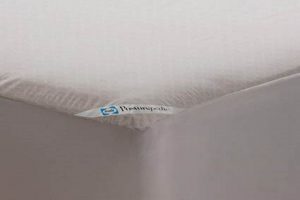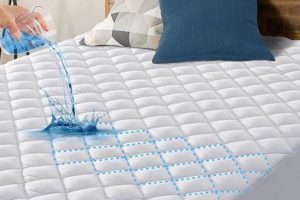A sleep surface encasement designed to shield a mattress from fluids, allergens, and potential damage, typically constructed from breathable and waterproof materials, enhances the lifespan and hygiene of the underlying bed. This type of protective layer commonly utilizes features such as hypoallergenic fabrics and secure fitting mechanisms to provide comprehensive coverage.
These protective coverings are critical for maintaining a sanitary sleep environment, guarding against dust mites, pet dander, and accidental spills. This contributes to improved sleep quality and potentially alleviating allergy symptoms. Historically, basic coverings offered minimal protection; advancements in materials and construction have yielded significantly more effective and comfortable solutions.
This article will now delve into the specific features, benefits, and considerations relevant when selecting a mattress encasement tailored to individual needs and preferences.
Essential Considerations for Mattress Protection
Selecting an appropriate sleep surface encasement requires careful evaluation of several factors to ensure optimal performance and longevity.
Tip 1: Material Composition: Prioritize encasements constructed from breathable, waterproof materials, such as polyurethane laminates or specialized performance fabrics. These materials offer a barrier against liquids and allergens while promoting airflow, preventing excessive heat build-up.
Tip 2: Allergen Protection: Look for certifications confirming the product’s efficacy in blocking dust mites and other common allergens. Tight-weave fabrics and secure closures are essential for preventing allergen penetration.
Tip 3: Secure Fit: A properly fitted encasement is crucial for optimal protection. Measure the mattress’s depth accurately and select an encasement with deep pockets and a secure fastening system, such as a zipper or elastic band, to prevent shifting or slippage.
Tip 4: Maintenance and Care: Consider the ease of cleaning and maintenance. Opt for machine-washable encasements for convenient hygiene maintenance. Follow the manufacturer’s care instructions to preserve the encasement’s integrity and performance.
Tip 5: Breathability and Comfort: Prioritize breathability to minimize heat retention and ensure a comfortable sleep experience. Performance fabrics with moisture-wicking properties can further enhance comfort, especially for individuals prone to night sweats.
Tip 6: Zipper Quality and Security: Examine the zipper system of the mattress protector. A high-quality, durable zipper that fully encloses the mattress and includes a locking mechanism is crucial to prevent the ingress of bed bugs and other pests.
Implementing these considerations during the selection process will facilitate choosing a sleep surface encasement that effectively safeguards the mattress and promotes a healthier sleep environment.
The following section will explore specific features and performance characteristics of leading encasement models.
1. Waterproof Barrier
The integration of a waterproof barrier is a fundamental characteristic of a high-quality sleep surface encasement. This feature directly impacts the protector’s ability to defend the underlying mattress against liquid intrusion, thereby preventing potential damage and maintaining a hygienic sleep environment. The effectiveness of this barrier is central to the overall performance and value of any mattress protection product.
- Liquid Ingress Prevention
The primary function of a waterproof barrier is to impede the passage of fluids, such as spills, sweat, or accidental incontinence. A failure in this regard can lead to staining, odor development, and the proliferation of mold and bacteria within the mattress core. Polyurethane laminates are commonly employed to create this barrier, offering reliable impermeability when properly integrated.
- Material Integrity
The waterproof barrier’s durability is paramount. Repeated use, washing, and general wear and tear should not compromise its ability to repel liquids. Some materials may degrade over time, leading to pinholes or weakened areas that allow moisture penetration. Robust materials and careful manufacturing processes are crucial to maintaining long-term performance.
- Breathability Considerations
A completely impermeable barrier can impede airflow, leading to heat buildup and discomfort. Advanced mattress protectors incorporate breathable waterproof membranes that allow air and moisture vapor to escape while preventing liquid entry. This balance between protection and breathability is vital for a comfortable sleep experience.
- Hypoallergenic Properties
A robust waterproof layer indirectly contributes to hypoallergenic properties. By preventing moisture accumulation, it inhibits the growth of mold and mildew, common allergens that can exacerbate respiratory issues. Furthermore, it provides a barrier against dust mites, another significant allergen.
The success of a mattress encasement is heavily reliant on the quality and effectiveness of its waterproof barrier. Its ability to prevent liquid damage, maintain hygiene, and contribute to a comfortable sleep environment ultimately determines the product’s value and suitability for long-term mattress protection. Proper selection considers not only the presence of a waterproof barrier, but also its durability, breathability, and overall integration with the encasement’s design.
2. Allergen Resistance
Allergen resistance in mattress protection is a critical feature that significantly influences the quality of sleep and overall well-being, especially for individuals with sensitivities or allergies. A sleep surface encasement engineered to resist allergens mitigates exposure to common triggers, contributing to a healthier and more comfortable rest.
- Dust Mite Barrier
Dust mites are a prevalent allergen found in bedding, feeding on shed skin cells. A tightly woven fabric encasement creates an impermeable barrier, preventing dust mites from colonizing the mattress core. This barrier reduces allergen exposure and minimizes the risk of allergic reactions, such as rhinitis, eczema, and asthma.
- Pet Dander Prevention
Pet dander, consisting of microscopic flecks of skin shed by animals, is another common allergen. Similar to dust mites, a protective encasement can effectively prevent pet dander from penetrating the mattress. This is particularly beneficial for pet owners or individuals with allergies to animal proteins.
- Mold and Mildew Inhibition
Moisture accumulation within a mattress can promote the growth of mold and mildew, potent allergens that can trigger respiratory issues. A waterproof encasement prevents moisture ingress, thus inhibiting the proliferation of these allergens. Materials with antimicrobial properties can further enhance mold and mildew resistance.
- Hypoallergenic Material Selection
The materials used in the construction of the encasement itself should be hypoallergenic. This minimizes the risk of allergic reactions to the fabric or treatments applied to the protector. Materials like cotton or specially treated synthetic fibers are often chosen for their low allergenic potential. Certifications such as Oeko-Tex Standard 100 ensure the absence of harmful substances that could trigger allergic responses.
The combined effect of these allergen-resistant features results in a sleep environment less conducive to triggering allergies, promoting improved sleep quality and respiratory health. Selection of a mattress encasement with verified allergen resistance is a proactive measure for creating a healthier sleep space.
3. Breathability
Breathability, in the context of a mattress protector, refers to the capacity of the material to permit the circulation of air and the transmission of moisture vapor. The interaction between body heat and the mattress can create a humid microclimate that disrupts sleep. A protector lacking breathability exacerbates this issue, leading to increased body temperature, perspiration, and discomfort. The design of the cover is critical for managing thermoregulation while preserving the protection of mattress.
The selection of materials plays a key role in the breathability of these mattress encasements. Natural fibers such as cotton or innovative synthetics engineered with moisture-wicking capabilities allow for the free flow of air, mitigating heat buildup. Consider a protector constructed with a non-breathable polyurethane layer; this creates a barrier against liquids but traps heat, leading to discomfort. The impact of a protectors design is apparent in the sleeper’s experience; reduced restlessness, decreased perspiration, and improved overall sleep quality may result from enhanced ventilation.
Therefore, understanding the breathability characteristics of a mattress protector is crucial for maximizing sleep quality and promoting hygiene. The integration of breathable components addresses the fundamental challenge of moisture and temperature control.
4. Secure Encasement
Secure encasement is a defining characteristic of effective mattress protection, critical to the performance and longevity of products such as bedgear mattress protectors. This design element refers to the degree to which a mattress protector fully and securely envelops the mattress, safeguarding it against a multitude of potential threats. The efficacy of secure encasement is a direct determinant of the protector’s ability to function as intended. For example, a protector with a loose or ill-fitting design allows ingress of allergens, fluids, and pests, negating its protective purpose. Conversely, a secure, tightly sealed encasement offers comprehensive protection against these elements. This includes the ability to block liquids from penetrating the mattress, prevent dust mites and bed bugs from establishing residence, and maintain a cleaner, more hygienic sleep environment.
The practical applications of a secure encasement extend to the durability and lifespan of the mattress itself. By preventing the accumulation of contaminants and physical wear, a securely fitted protector helps maintain the mattress’s structural integrity and comfort over time. The secure design impacts the effectiveness of the protector during routine use. For example, a protector that shifts or bunches up exposes sections of the mattress, thus negating its purpose. Zippers and sealed seams add to the security. The zipper prevents mites, insects, and liquids from entering the mattress. The design of the zipper should be durable and long lasting. Some secure encasements will also include mattress straps that assist in the non-movement of the cover as well.
In summary, secure encasement is not merely a feature of a mattress protector but a fundamental requirement for its effectiveness. Its implementation has far-reaching implications for hygiene, comfort, and the long-term preservation of the mattress. Understanding the importance of secure encasement facilitates informed purchasing decisions, ensuring selection of a product that genuinely fulfills its intended purpose.
5. Washability
Washability is a defining characteristic of a mattress protector that directly impacts hygiene maintenance and longevity. Regular cleaning sustains a sanitary sleep environment, extending the lifespan and effectiveness of the protector. The ease with which a sleep surface encasement can be cleaned is, therefore, a critical consideration in its selection and long-term value.
- Frequency of Cleaning
The recommended cleaning frequency for a mattress protector varies depending on individual circumstances, such as presence of allergies, pets, or tendency to sweat during sleep. However, as a general guideline, washing the protector every one to two months is advisable to remove accumulated dust mites, allergens, and body oils. Failure to adhere to a regular cleaning schedule can compromise the protector’s hygienic properties and reduce its lifespan.
- Washing Machine Compatibility
Mattress protectors are designed to be machine washable. Examine the product’s care instructions. High temperatures and harsh detergents can damage the waterproof membrane, compromising its integrity. A gentle cycle with cold or lukewarm water and a mild detergent is generally recommended. Additionally, avoid using fabric softeners or bleach, as these substances can degrade the protector’s materials.
- Drying Procedures
Proper drying is as crucial as washing in maintaining the quality of a mattress protector. High heat can cause the waterproof layer to melt or delaminate, rendering the protector ineffective. Tumble drying on a low heat setting or air drying is the preferred method. Ensuring the protector is completely dry before placing it back on the mattress prevents moisture buildup, which can lead to mold growth.
- Material Durability
The materials used in the construction of a mattress protector should be robust enough to withstand repeated washing cycles without compromising their protective qualities. Flimsy materials may tear, shrink, or lose their waterproof properties after a few washes. Protectors made from durable, high-quality fabrics are more likely to maintain their performance over time.
Considering these facets of washability ensures that a mattress protector remains a hygienic and effective barrier against allergens, liquids, and other contaminants. Regular cleaning, using appropriate methods, extends its lifespan and contributes to a healthier sleep environment.
Frequently Asked Questions
This section addresses common inquiries concerning mattress protectors, focusing on functionality, maintenance, and selection criteria. The information presented aims to clarify misunderstandings and provide guidance for optimal product use.
Question 1: Does a mattress protector alter the feel of the mattress?
A mattress protector can influence the feel of the underlying mattress, depending on its construction and materials. Thicker protectors or those with quilted surfaces may add a slight degree of cushioning. However, a quality protector is designed to minimize alterations to the original mattress feel while maximizing protection.
Question 2: Can a mattress protector eliminate the need for a mattress warranty?
A mattress protector does not substitute for a mattress warranty. Warranties cover manufacturing defects and structural issues, whereas a protector guards against stains, spills, and other forms of damage. Using a protector can preserve warranty validity, as stain damage often voids warranty claims.
Question 3: How frequently should a mattress protector be replaced?
The replacement frequency of a mattress protector depends on its quality, usage, and care. High-quality protectors, properly maintained, may last several years. Signs of wear, such as tears, diminished waterproofness, or persistent staining, indicate the need for replacement.
Question 4: Are all mattress protectors bed bug proof?
Not all mattress protectors are specifically designed to be bed bug proof. A bed bug-proof protector features a tightly woven fabric and a secure zipper closure that completely encases the mattress, preventing bed bugs from entering or escaping. Products marketed as bed bug proof should have verifiable certifications.
Question 5: Can a heated mattress pad be used in conjunction with a mattress protector?
A heated mattress pad can typically be used with a mattress protector, but it is critical to verify compatibility with both manufacturers’ guidelines. The protector should not impede the heated pad’s functionality or pose a safety risk. Consider placing the protector directly on the mattress, followed by the heated pad, to optimize heat distribution.
Question 6: Does a mattress protector impact breathability and temperature regulation?
A mattress protector can affect breathability and temperature regulation. Non-breathable materials can trap heat, leading to discomfort. High-quality protectors use breathable fabrics designed to facilitate airflow and moisture wicking, minimizing temperature fluctuations and promoting a more comfortable sleep environment.
The information in this FAQ section offers clarity on key aspects of mattress protectors. By understanding their functionality, maintenance requirements, and proper selection criteria, consumers can optimize their investment and enjoy a cleaner, more comfortable sleep environment.
The next section will explore the environmental and health certifications relevant to mattress protectors.
In Summary
This exploration has detailed the salient features of mattress protection, emphasizing the integration of waterproof barriers, allergen resistance, breathability, secure encasement, and washability. bedgear mattress protector products aim to provide a comprehensive approach to safeguarding mattresses, thereby extending their lifespan and contributing to a cleaner sleep environment. The importance of selecting a protector tailored to individual needs and considering the long-term implications for both mattress longevity and personal health has been underlined.
The selection of a mattress protector represents a proactive investment in sleep hygiene and mattress preservation. Continued innovation in materials and design suggests a future trajectory of enhanced performance and sustainability in this product category. Ultimately, informed decision-making remains paramount in leveraging the benefits of mattress protection.


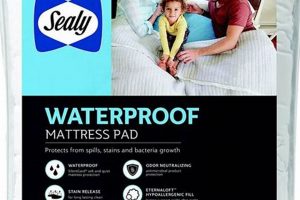
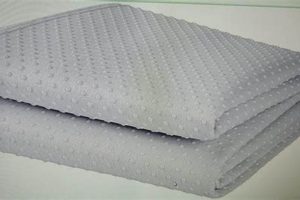
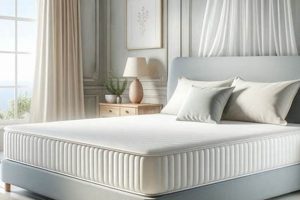
![Cool Tempur-Pedic Comfort: Cooling Mattress Protector [Guide] Organic & Natural Mattress Buyer’s Guide: Non-Toxic Sleep Solutions Cool Tempur-Pedic Comfort: Cooling Mattress Protector [Guide] | Organic & Natural Mattress Buyer’s Guide: Non-Toxic Sleep Solutions](https://mattressworldpa.com/wp-content/uploads/2025/07/th-2523-300x200.jpg)
